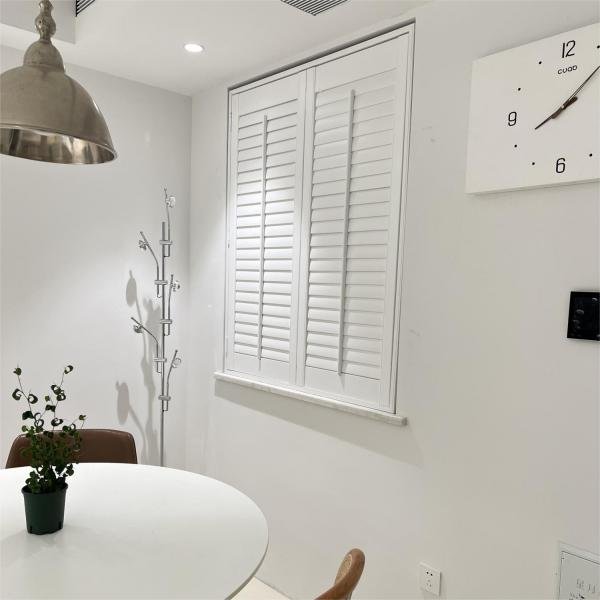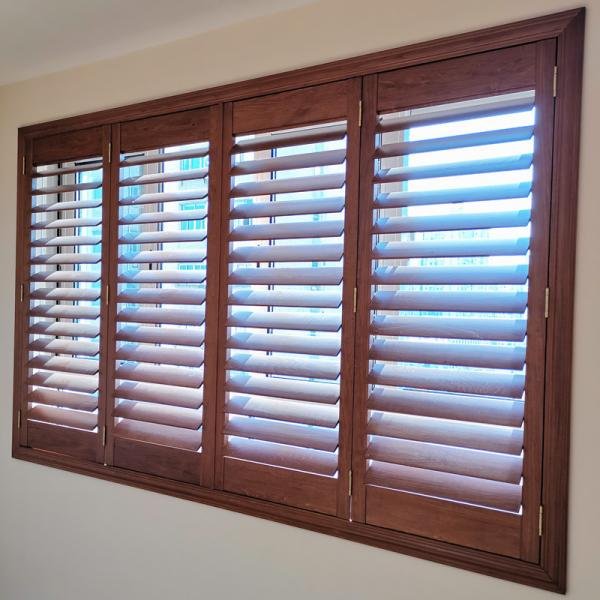
Plantation shutters are a sophisticated and fashionable way to control light and airflow in your home. They can be customized to match any decor and are made from a variety of materials such as wood, PVC, or composite.
Shutters are a great option for any home, whether you want a classic look or something more modern. Wood shutters are timeless and elegant, whereas PVC shutters are less expensive and easier to maintain. Composite shutters combine the beauty of wood with the durability of PVC to provide the best of both worlds.
This article will explain the differences between the six most commonly used interior shutter materials so you can make an informed decision about which material is best for your custom window shutter projects.
Plantation shutters are a sophisticated and fashionable way to control light and airflow in your home. They can be customized to match any decor and are made from a variety of materials such as wood, PVC, or composite.
Shutters are a great option for any home, whether you want a classic look or something more modern. Wood shutters are timeless and elegant, whereas PVC shutters are less expensive and easier to maintain. Composite shutters combine the beauty of wood with the durability of PVC to provide the best of both worlds.
The Best Material for Interior Window Shutters
Interior wood shutters are a unique option. They have an undeniable wooden feel when they open and close. Interior shutters have been made with natural wood for hundreds of years, and most shutter manufacturers still use them today.
While interior shutters are not a new concept, wood shutters for windows are quickly replacing traditional window coverings such as drapes and curtains for a variety of reasons, including providing excellent heat and glare protection without obstructing your view in a room and adding value to your home.
There are numerous types of wood, each with unique properties that will be important for your project. For example, some woods are stronger than others, while others are lighter, with better staining and painting properties. The right wood material for your interior shutters can make or break their longevity and beauty. Here are the five most popular interior wood shutter options.
Plantation Shutters Made of Basswood
Basswood shutters are the most popular type of wood window shutter. It has a closed grain and produces less sap, making primer and stains easier to apply. Because of the slow growth, the wood is straighter and cracks less, making it a far better choice than other woods. This is still one of the best options for Tier-on-Tier Styles or large panels, such as conservatory windows.
Basswood is a hard, durable wood that resists warping and is resistant to heat and water. That means you can put them in places where you wouldn’t normally put wood shutters, like bathrooms and kitchens. This adaptable species can also be used to make food containers, surfboards, and other custom projects.
Plantation Shutters Made of White ash
The white ash wood has a very deep grain that can be seen when it is painted or stained. This wood is used for a variety of purposes, including the manufacture of baseball bats and carpenter’s hand tools, as well as tables and shutters. White ash wood shutters have a more charismatic appearance than light-colored wood shutters.

For those who appreciate deep grains, ash shutters are an excellent choice. The wood’s deep grain is best highlighted with a rich stain available in a variety of colors. With this wood type, we also offer paint finishes. We pay attention to every detail and apply a rag-rubbed stain by hand to ensure the color is evenly spread and consistent.
Plantation Shutters Made of Pine
Pine shutters are a long-lasting and inexpensive wood product made from sustainably harvested timber. The shutters are made from the Pine tree, which is dense and grows slowly. It is primarily used in flooring, furniture, and fencing.
This is our most affordable yet high-performance option, ideal for those looking for a high-quality option without breaking the bank. Monterey Pine shutters are a long-lasting, low-cost option with a beautiful, straight grain. However, knots are common, so a painted finish is often recommended to keep it looking elegant.
Plantation Shutters Made of Poplar
Poplar is a sustainable hardwood that can be used to make shutters for larger windows and doors. This versatile wood is extremely simple to work with, making it ideal for larger projects. It’s tough and fast-growing, but most importantly, it’s ideal for paint jobs because it produces a high-quality finish.
Poplar shutters are a popular choice among manufacturers worldwide. Poplar wood plantation shutters hold paint and enamel well, making them durable and long-lasting. They are strong and stable due to their medium density, low shock resistance, bending, and stiffness.

Plantation shutters are the latest craze, but they can be costly. Poplar is an excellent material for plantation shutters because it is widely available and less expensive than basswood.
Plantation Shutters Made of Paulownia
Paulownia shutters wood has a fine, knot-free grain that makes it ideal for painting or staining. Paulownia is a fast-growing, lightweight hardwood native to Northern Asia. Although it is hardwood, it is approximately one-third lighter in weight than other hardwoods, making it an excellent choice for Tier-on-Tier or wider openings.

UV-stabilizing paint is used to protect Paulownia shutters from the elements of sunlight. Paulownia shutters come in two varieties: mono and dual closures. Mono closures are block-painted in colors that coordinate with Basswood and PVC shutters. The dual closures have a “Rustic” finish, which resembles a whitewash finish.
Plantation Shutters Made of PVC
Shutters are made of hollow PVC, solid PVC, and solid aluminum-reinforced PVC. Despite their various names, all of these shutters are made of synthetic materials that are designed to look like wood. Solid PVC shutters are more durable than hollow PVC shutters because they are lighter and easier to install. The most durable option is solid aluminum-reinforced PVC shutters, but they are also the most expensive.

What Material Should You Use for Your Shutters?
Plantation shutters are available in a variety of materials, with real wood, composite, and PVC being the most popular. Each of the three options has unique characteristics that make them ideal for modern homes. However, deciding on the best plantation shutters for your specific requirements can be difficult.
Here are 5 pointers to consider when selecting the best plantation shutter material for your needs:
Budget
When it comes to selecting shutters for your home, your budget will play a significant role in limiting your options. Because wood is a natural resource, real wood shutters are generally more expensive than composite or PVC shutters, and manufacturing wooden shutters can be costly due to the lengthy and laborious process. Composite and PVC shutters, on the other hand, are man-made and tend to be less expensive than their wooden counterparts. So, depending on your budget, you may have to sacrifice some aesthetics to save money.
Aesthetics
There are numerous reasons why real wood is the superior choice for window shutters. It is not only more aesthetically pleasing, but also more durable and long-lasting. The primary distinction between real wood and faux wood shutters is that real wood shutters are available in a wider range of colors. They can also be sanded and stained to produce a variety of colors and textures, giving you more decorating options. While PVC or composite shutters provide what you see, their color options are more limited.
Size
Size is an important consideration when choosing a shutter material. Small shutters give you more options for what will work well. Small shutters can be made from wood, PVC, or composite materials. Larger shutters, on the other hand, require more stability and durability, limiting your options to materials like wood. Because wood is both stronger and lighter than PVC or composite material, it is an excellent choice for large shutters. PVC and composite shutters may warp and sag over time, making them unsuitable for large shutters.
Climate
When you live in a dry climate, you can use any material for your shutters. For humid climates where condensation accumulates, such as in your kitchen or bathroom, PVC and composite shutters are the best options. These materials are extremely resistant to humidity and wet weather, making them ideal for use in areas where condensation is common, such as kitchens and bathrooms. In damp climates, wood shutters can rot, so regular maintenance is required to keep them in good condition.
Maintenance
Although wooden shutters can add a lot of character to a home, they are more difficult to maintain than composite or PVC shutters. Wooden shutters are susceptible to mold, pests, and moisture, so you’ll need to inspect and clean them regularly to keep them in good condition. Composite and PVC shutters are made of a plastic-based material that will not mold or decay over time and can be cleaned with a simple wipe-down.






Leave a Reply